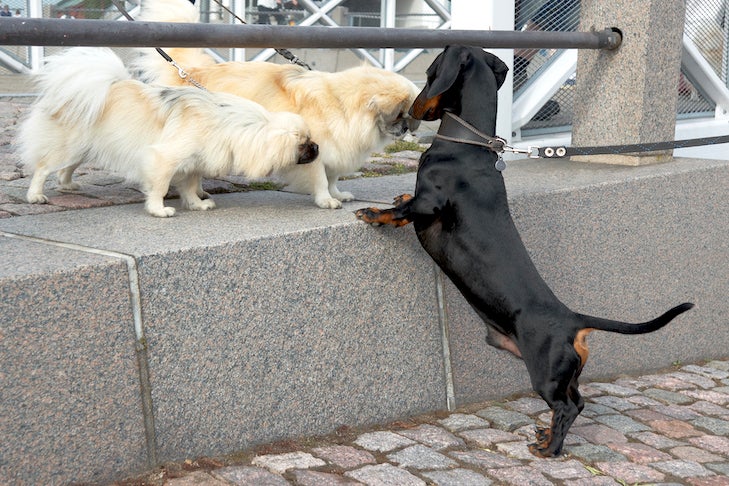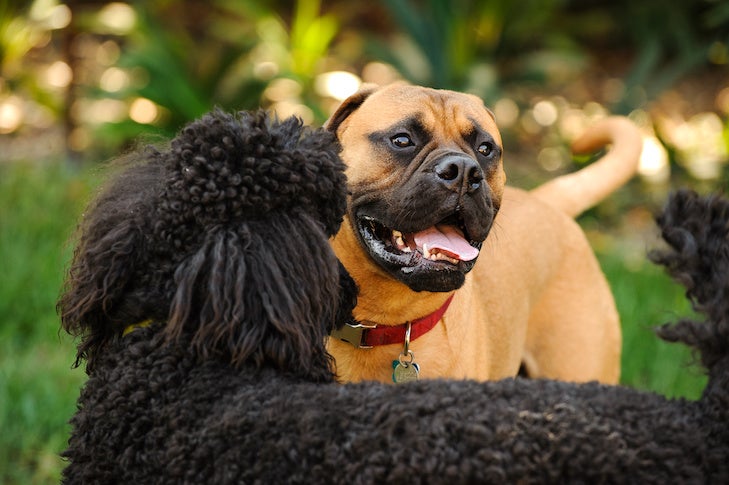Do you run up to and hug or jump on every person you see on the street? Of course not. Similarly, it’s important to teach our dogs not to try to engage with all the other dogs they pass during a walk.
As the world reopens after the pandemic, people are bringing their dogs more places and are often putting a lot of pressure on their pups to be social with other dogs. In reality, it’s far better for dogs to have space and not be pushed to interact. Most adult dogs are dog selective or dog tolerant, meaning they don’t want to be greeted by strange dogs.
Dangerous Interactions
Socialization is a term that gets thrown around a lot, but it actually refers to a very specific period of puppy development. That said, you can teach adult dogs new skills and they don’t need to greet or engage with other dogs to be happy or fulfilled. In fact, allowing your dog to greet every dog you see can lead to longer-term behavioral issues.
If you allow your dog to approach a strange dog, it puts your pet at risk for injury or illness. One of the big concerns is that those unknown dogs might be unvaccinated or ill with a contagious condition. It’s also impossible to tell if they will be a good match for your dog’s temperament. They might have had negative interactions in the past with other dogs or may be in training. The other dog may not appreciate being greeted, which could lead to your dog getting lunged at or being caught up in a dog fight. Not only could this result in your dog getting injured, but it could also lead to long-term nervousness or even reactivity to other dogs.
Encouraging Neutrality
Rather than encouraging your dog to engage with other dogs, it’s far safer to teach them neutrality by asking your dog to turn attention toward you instead. This skill is easiest to teach with young puppies when you first introduce them to walking by rewarding them for any attention they give you on a walk. But while it’s great to start building these skills when your dog is you, you can absolutely teach it and reinforce it with older dogs.
To create neutrality toward other dogs when you’re out in public, your goal is to make yourself more interesting and “valuable” to your dog. We want our dogs to understand that going out with us anywhere—from a neighborhood walk to dog-friendly events—is a chance to play and engage with us and not other dogs. By avoiding setups where our dogs routinely greet strange dogs, we can teach them that paying attention to us is more fun and rewarding.

Creating Space
Even if your dog is very friendly, if you see a dog in public, it’s a good idea to create as much space as possible between the two of them. This will generally make the dogs calmer and less focused on each other. If you see a dog approaching, it’s a good idea (if possible) to cross to the other side of the street or give space to another dog and their owner. If you’re in a crowded area where moving across the street isn’t practical, you can cross your dog to the other side of you to put your body between your dog and an approaching dog. This helps create space in case the other dog lunges. When you’re first teaching your dog to ignore other dogs, that space can also make it easier for your dog to stay calm and focused on you.
To start training your dog to create space on cue, you can teach them to cross from walking on one side to the other. It’s your preference if you want your dog to cross in front or behind you. For dogs who tend to lag, crossing behind is usually easier, while dogs who forge ahead on their walks might find it easier to cross in front.
Step 1: While walking your dog, use a toy or treat to lure them from one side to the other, then praise and reward. Be sure to practice going both directions.
Step 2: After several repetitions of luring your dog to cross to the other side, you can begin to incorporate a verbal cue of your choice such as “cross,” or “left” or “right” to indicate what side the dog should be on.
Step 3: As your dog becomes more confident with this cue after several practice sessions, you can start to reduce and then fade out your treat/toy lure entirely and just reward them once they have crossed to your other side on cue.
Practice teaching your dog to intentionally cross sides in a low-distraction environment and then build up the skill to more distracting areas like parks or crowded streets.
Teaching ‘Watch’
‘Watch’ is one of the most useful skills you can teach your dog that will help them ignore distractions when out on a walk. For this skill, your dog will make eye contact with you, which is a great way to stop them from getting over-aroused or excited by the presence of the other dog.
Step 1: To teach your dog to watch you, have a treat in front of them and slowly bring the treat up to your nose/between your eyes.
Step 2: Your dog will watch the treat and make eye contact with you. Praise and treat your dog as they look at your eyes.
Step 3: After a few repetitions of luring your dog to look at your face with a treat, you will want to do the same physical lure but with an empty hand.
Step 4: When your dog follows your empty hand and looks at your face, praise and treat.
Step 5: After several training sessions when your dog is consistently following your hand signal to watch your face, you can start to introduce a verbal cue of your choice such as “watch” or “eyes.”
Again, start by practicing this skill inside your house so your dog won’t be distracted and then move gradually to other environments that are more distracting.

Advocate For Your Dog
You’ll likely come across a situation where a dog approaches uninvited to greet your dog. In these situations, it’s always okay to interrupt the interaction and prevent the dog from approaching your dog. Our dogs look to us to keep them safe and comfortable when out in the world. Part of continuing their neutrality toward other dogs is ensuring they have positive interactions and understand that we won’t permit them to be ambushed or approached.
Don’t worry about being rude to a stranger—the most important thing is to stand up for your dog’s comfort. It’s okay to interrupt people who are approaching your dog or allowing their dog to approach and say “no.” You could also say something like “my dog is training,” or “my dog is sick,” or “my dog is recovering” or just simply “my dog doesn’t want to say hi.” If a verbal rejection doesn’t encourage someone to move their dog out of your dog’s space, try to create physical distance. If necessary, put yourself physically between your dog and an oncoming dog to prevent them from approaching.
But My Dog Is Friendly!
While many dogs enjoy the opportunity to play with dogs they know, most adult dogs don’t enjoy social interactions with every single dog they see. Unfortunately, social media and dog park culture stereotypes suggest that all dogs should be friends with one another. This leads to owners allowing — or even pushing — their dogs to interact (often rudely) with other dogs they meet in public. Although most puppies are very dog social, in adulthood most dogs become dog selective or dog tolerant, with very few remaining truly dog social. Some may even become dog reactive.
Hearing someone proclaim “but my dog is friendly” can be frustrating for many dog owners, especially when their dogs are being bombarded by young, boisterous dogs whose owners have let off-leash but have no off-leash recall. Unfortunately, these negative interactions can lead to dogs developing behavioral challenges like reactivity. If your dog does enjoy meeting and playing with dogs, be sure to seek consent before allowing them to approach another dog. Or, better yet, connect with other dog owners to set up planned playdates with dogs you know are vaccinated, healthy, social, and have a compatible play style with your dog.

